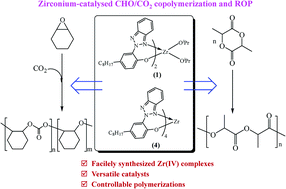Facilely synthesized benzotriazole phenolate zirconium complexes as versatile catalysts for copolymerization of carbon dioxide with cyclohexene oxide and lactide polymerization†
Abstract
A family of zirconium complexes containing bis-, tri- or tetra-BTP ligands (BTP = benzotriazole phenolate) were synthesized and structurally characterized. Treatment of Zr(OiPr)4(iPrOH) with 2.0 molar equivalents of 2-(2H-benzotriazol-2-yl)-4-(2,4,4-trimethylpentan-2-yl)phenol (C8BTP-H) or 2-(2H-benzotriazol-2-yl)-4,6-di-tert-butylphenol (t-BuBTP-H) afforded zirconium alkoxide ([(C8BTP)2Zr(OiPr)2] (1); [(t-BuBTP)2Zr(OiPr)2] (2)) in good yield. Similarly, the bis-adduct Zr amide [(t-BuBTP)2Zr(NMe2)2] (3) resulted from amine elimination of Zr(NMe2)4 as the metal precursor and t-BuBTP-H as the pro-ligand under a similar synthetic method with a metal to ligand precursor ratio of 1 : 2 at 0 °C. The reaction of Zr(NMe2)4 with C8BTP-H or t-BuBTP-H (4.0 mol equiv.) gave the tetra-adduct zirconium complex ([(C8BTP)4Zr] (4); [(t-BuBTP)4Zr] (5)) in ≧70% yield. Interestingly, the tri-adduct Zr amide [(t-BuBTP)3Zr(NMe2)] (6) could be prepared by treatment of 3 with a stoichiometric amount of t-BuBTP-H. The solid-state structure of 6 reveals a monomeric Zr(IV) amide with three t-BuBTP ligands and one –NMe2 group, and the bonding modes between the BTP moiety and the metal centre adopt both N,O-bidentate and O-monodentate types. Zr complexes 1 and 4 incorporating sterically less bulky C8BTP ligands were demonstrated to efficiently catalyse not only copolymerization of epoxide with CO2 but also lactide polymerization. The tetra-BTP Zr catalyst 4 was able to copolymerize cyclohexene oxide and CO2 in a controllable manner, generating the high-molecular-weight copolymer (Mw > 10 000 g mol−1) and a high degree of carbonate linkages (>90%). Single-site zirconium alkoxide 1 is the most active catalyst for living lactide polymerization in solution among these complexes, giving poly(lactide)s with the expected molecular weights and narrow molecular weight distributions (PDI ≦ 1.25). This is a successful example of utilizing versatile benzotriazole phenolate Zr(IV) catalysts for either the production of biodegradable poly(lactide) or poly(cyclohexene carbonate-co-cyclohexene oxide).


 Please wait while we load your content...
Please wait while we load your content...